Abstract
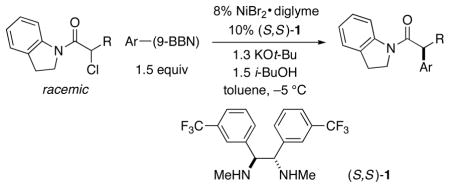
A nickel-catalyzed stereoconvergent method for the enantioselective Suzuki arylation of racemic α-chloroamides has been developed. This process represents the first example of an asymmetric arylation of an α-haloamide, of an enantioselective arylation of an α-chlorocarbonyl compound, and of an asymmetric Suzuki reaction with an activated alkyl electrophile or an arylboron reagent. The method is also applicable to the corresponding enantioselective cross-coupling of α-bromoamides. The coupling products can be transformed without racemization into useful enantioenriched α-arylcarboxylic acids and primary alcohols. An unprecedented (and modest) kinetic resolution of the α-chloroamide has been observed; a mechanistic study indicates that the selectivity likely reflects the discrimination by the chiral catalyst of the two enantiomeric α-chloroamides in an irreversible oxidative-addition process.
Enantioenriched α-arylcarboxylic acids that bear a tertiary α stereocenter, including arylpropionic acids such as naproxen, serve as important therapeutics as well as useful intermediates in organic synthesis.1,2 Although the cross-coupling of enolates with aryl electrophiles has not yet proved to be a viable route to the generation of such compounds,3 a few reports have described the umpolung approach, i.e., the coupling of an α-halocarbonyl compound with an aryl nucleophile. Whereas organozinc,4 organosilicon,5 and organomagnesium6 reagents have been employed in such processes (with α-bromoketones and α-bromoesters), organoboron compounds have not.7,8,9,10 In this report, we establish that a chiral nickel catalyst can achieve asymmetric cross-couplings of arylboron reagents with racemic α-haloamides to generate tertiary α-arylcarbonyl compounds in good ee (eq 1).
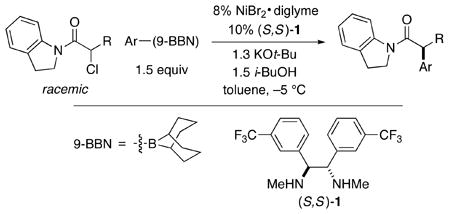 |
(1) |
After surveying an array of reaction parameters, we determined that NiBr2· diglyme/1 can catalyze the cross-coupling of an α-chlorobutyramide with Ph-(9-BBN) in good ee and yield (entry 1 of Table 1). The cross-coupling illustrated in entry 1 is noteworthy in part because there are no previous examples of enantioselective arylations of α-haloamides, of asymmetric Suzuki reactions of activated alkyl electrophiles or arylboron11 reagents, or of enantioselective arylations of α-chlorocarbonyl compounds.12 Both NiBr2· diglyme and ligand 1 are commercially available.
Table 1.
Effect of Some Reaction Parameters on the Asymmetric Suzuki Arylation of a Racemic α-Chloroamide.
 | |||
|---|---|---|---|
| entry | variation from the “standard” conditions | ee (%) | yield (%)a |
| 1 | none | 92 | 89 |
| 2 | no NiBr2·glyme | – | <2 |
| 3 | no (S,S)-1 | – | 8 |
| 4 | no i-BuOH | – | 8 |
| 5 | water, instead of i-BuOH | 91 | 25 |
| 6 | (S,S)-2, instead of (S,S)-1 | 85 | 74 |
| 7 | r.t. | 82 | 84 |
| 8 | 4% NiBr2· glyme, 5% (S,S)-1 | 91 | 78 |
| 9 | X = NBnPh | – | 6 |
| 10 | X = NPh2 | – | 4 |
| 11 | X = NEt2 | 76 | 19 |
| 12 | X = NMe(OMe) | <5 | 84 |
| 13 | X = NHMe | 26 | 82 |
| 14 | X = OEt | 50 | 74 |
All data are the average of two experiments.
The yield was determined by GC or 1H NMR analysis versus an internal standard.
In the absence of NiBr2· diglyme, essentially no carbon–carbon bond formation is observed (entry 2 of Table 1), and, in the absence of ligand 1, the cross-coupling proceeds very slowly (entry 3). If i-BuOH is omitted, the reaction is also sluggish (entry 4), and, if water is used in place of i-BuOH, the product is generated with good enantioselectivity, but modest yield (entry 5). The cross-coupling occurs with somewhat lower ee if ligand 2 is employed rather than ligand 1 (entry 6) or if it is conducted at room temperature (entry 7). Use of less catalyst leads to a slightly diminished yield (entry 8). A variety of other α-chloroamides (both tertiary and secondary), as well as an α-chloroester, are less suitable cross-coupling partners than the indolinylamide (entries 9–13).

Cross-couplings that illustrate the scope of this new stereoconvergent method for the synthesis of α-arylcarboxylic acid derivatives are provided in Table 2.13 Functional groups such as an olefin and a silyl ether (entries 3 and 4), as well as β branching (entry 5), are tolerated in the alkyl side chain of the electrophile. For the nucleophile, a meta (entries 6 and 7) or a para (entries 8 and 9) substituent can be present, and it can be electron-withdrawing (entry 6) or electron-donating (entries 7 and 8). This asymmetric Suzuki cross-coupling proceeds with comparable efficiency on a gram scale, and the product amide can be recrystallized to >99% ee (entry 2 of Table 2: 92% ee and 88% yield before recrystallization; >99% ee and 70% yield after recrystallization).
Table 2.
Asymmetric Suzuki Arylations of α-Chloroamides (see eq 1).
| entry | R | Ar | ee (%) | yield (%)a |
|---|---|---|---|---|
| 1 | Et | Ph | 92 | 78 |
| 2 | Me | Ph | 87 | 88 |
| 3 | CH2CH=CH2 | Ph | 90 | 80 |
| 4 | CH2CH2OTBS | Ph | 84 | 80 |
| 5 | i-Bu | Ph | 85 | 84 |
| 6b | Et | 3-ClC6H4 | 92 | 76 |
| 7 | Et | 3-MeC6H4 | 92 | 84 |
| 8 | Et | 4-OMeC6H4 | 90 | 80 |
| 9 | Et | 4-FC6H4 | 94 | 70 |
All data are the average of two experiments.
Yield of purified product.
10% NiBr2 · diglyme and 12.5% (S,S)-1 were used.
This method for catalytic enantioselective carbon–carbon bond formation was developed and optimized for Suzuki arylations of α-chloroamides. Nevertheless, it can be applied without modification to a racemic α-bromoamide, providing comparable results (eq 2).
 |
(2) |
The products of these asymmetric cross-coupling reactions can be reduced to a primary alcohol (83%; eq 3) or converted into an α-arylcarboxylic acid (e.g., an arylpropionic acid; eq 4). No racemization is observed.
 |
(3) |
 |
(4) |
As for the other nickel-catalyzed enantioselective cross-couplings of alkyl electrophiles that have been described to date,4–6,8a,14 this new asymmetric Suzuki reaction is also stereoconvergent: both enantiomers of the racemic starting material are converted preferentially into the same enantiomer of the product. However, in contrast to all of the other processes, in these Suzuki arylations the unreacted electrophile is kinetically resolved15 with a significant ee (eq 5).16
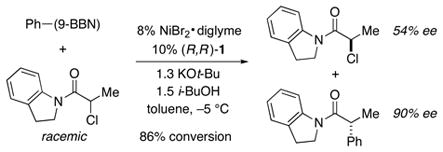 |
(5) |
Our observation that the recovered α-chloroamide is not racemic indicates that the enantiopure catalyst has the ability to differentiate between the two enantiomers of the starting material. The moderate ee of the unreacted electrophile even at high conversion could be due to modest differentiation of the enantiomers by the chiral catalyst, or it could result from excellent discrimination, but some reversibility, in the oxidative addition to nickel.17
In order to gain insight into this issue, we examined the Suzuki arylation of the individual enantiomers of the α-chloroamide (eq 6 and eq 7). For both cross-couplings, the ee of the unreacted electrophile at partial conversion is essentially unchanged, consistent with irreversible oxidative addition under the reaction conditions. Consequently, the ee observed in eq 5 for the recovered α-chloroamide likely reflects the inherent selectivity of the chiral catalyst toward the two enantiomers of the electrophile in the oxidative-addition step of the catalytic cycle (selectivity factor ~1.8).
The data in eq 6 and eq 7 illustrate that NiBr2· diglyme/(S,S)-1 transforms each enantiomer of the α-chloroamide into the same enantiomer of the product with essentially identical ee. This confirms the dominant role played by the chirality of the catalyst, rather than the substrate, in determining the ee of the product.
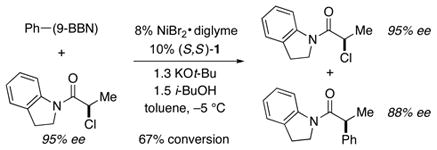 |
(6) |
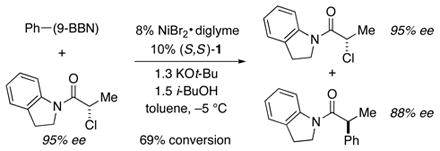 |
(7) |
In conclusion, we have developed a nickel-catalyzed stereoconvergent method for the enantioselective Suzuki arylation of racemic α-chloroamides that employs commercially available catalyst components (NiBr2· diglyme and ligand 1). This process represents the first example of an asymmetric arylation of an α-haloamide, of an enantioselective arylation of an α-chlorocarbonyl compound, and of an asymmetric Suzuki reaction with an activated alkyl electrophile or an arylboron reagent. The method is also applicable to the corresponding enantioselective cross-coupling of α-bromoamides. The coupling products can be transformed without racemization into useful enantioenriched α-arylcarboxylic acids and primary alcohols. An unprecedented (and modest) kinetic resolution of the α-chloroamide has been observed; a mechanistic study indicates that the selectivity likely reflects the discrimination by the chiral catalyst of the two enantiomeric α-chloroamides in an irreversible oxidative-addition process. Further efforts to develop catalytic asymmetric methods for cross-coupling alkyl electrophiles, as well as additional mechanistic studies, are underway.
Supplementary Material
Acknowledgments
We thank Dr. Francisco González-Bobes for preliminary studies. Support has been provided by the National Institutes of Health (National Institute of General Medical Sciences, grant R01–GM62871), Eli Lilly (fellowship to P.M.L.), Novartis (fellowship to P.M.L.), and the Merck Research Laboratories.
Footnotes
Supporting Information Available: Experimental procedures and compound characterization data (PDF). This material is available free of charge via the Internet at http://pubs.acs.org.
References
- 1.For leading references to the pharmacology of this family of compounds, see: Landoni MF, Soraci A. Current Drug Metabolism. 2001;2:37–51. doi: 10.2174/1389200013338810.
- 2.For a review of metal-catalyzed α-arylations of carbonyl compounds, including a discussion of the significance of the target compounds, see: Johansson CCC, Colacot TJ. Angew Chem, Int Ed. 2010;49:676–707. doi: 10.1002/anie.200903424.See also: Bellina F, Rossi R. Chem Rev. 2010;110:1082–1146. doi: 10.1021/cr9000836.
- 3.α-Arylcarbonyl compounds that bear tertiary α stereocenters are prone to racemization under the Brønsted-basic reaction conditions. (a) For a pioneering report on the catalytic asymmetric synthesis of α-arylcarbonyl compounds that bear quaternary α stereocenters, see: Åhman J, Wolfe JP, Troutman MV, Palucki M, Buchwald SL. J Am Chem Soc. 1998;120:1918–1919.For a review of catalytic enantioselective α-arylations of carbonyl compounds, see: Burtoloso ACB. Synlett. 2009:320–327.
- 4.Negishi reactions of α-bromoketones: Lundin PM, Esquivias J, Fu GC. Angew Chem, Int Ed. 2009;48:154–156. doi: 10.1002/anie.200804888.
- 5.Hiyama reactions of α-bromoesters: Dai X, Strotman NA, Fu GC. J Am Chem Soc. 2008;130:3302–3303. doi: 10.1021/ja8009428.
- 6.Kumada reactions of α-bromoketones: Lou S, Fu GC. J Am Chem Soc. 2010;132:1264–1266. doi: 10.1021/ja909689t.
- 7.The Suzuki reaction is perhaps the most widely used cross-coupling method. For leading references, see: Miyaura N. In: Metal-Catalyzed Cross-Coupling Reactions. de Meijere A, Diederich F, editors. Chapter 2 Wiley–VCH; New York: 2004. Negishi E-i., editor. Handbook of Organopalladium Chemistry for Organic Synthesis. Wiley Interscience; New York: 2002.
- 8.To the best of our knowledge, there has been one report of asymmetric Suzuki reactions of alkyl electrophiles (cross-couplings of unactivated homobenzylic bromides with alkylboron reagents): Saito B, Fu GC. J Am Chem Soc. 2008;130:6694–6695. doi: 10.1021/ja8013677.For leading references to asymmetric Suzuki reactions of aryl electrophiles that generate enantioenriched biaryl compounds, see: Bermejo A, Ros A, Fernandez R, Lassaletta JM. J Am Chem Soc. 2008;130:15798–15799. doi: 10.1021/ja8074693.
- 9.For leading references on asymmetric cross-couplings of secondary alkyl halides, see: Glorius F. Angew Chem, Int Ed. 2008;47:8347–8349. doi: 10.1002/anie.200803509.Rudolph A, Lautens M. Angew Chem, Int Ed. 2009;48:2656–2670. doi: 10.1002/anie.200803611.
- 10.For non-asymmetric nickel-catalyzed cross-couplings of α-bromoamides with arylboronic acids, see: Liu C, He C, Shi W, Chen M, Lei A. Org Lett. 2007;8:5601–5604. doi: 10.1021/ol702456z.
- 11.Although asymmetric Suzuki reactions of arylboron reagents with alkyl electrophiles have not previously been reported, enantioselective cross-couplings with aryl electrophiles have been described. For leading references, see Reference 8b.
- 12.For examples of reports that α-chlorocarbonyl compounds are not suitable cross-coupling partners in other enantioselective arylation processes, see footnote 16a of Reference 4 and footnote 16c of Reference 6.
- 13.Notes: (a) The ee of the product is essentially constant throughout the course of the reaction. (b) In preliminary studies under our standard conditions, the following compounds were not effective cross-coupling partners: an alkyl-(9-BBN), an alkenyl-(9-BBN), and an ortho-substituted aryl-(9-BBN); PhB(OH)2 and PhB(OR)2; the α-chloroamide with an α-i-Pr substituent.
- 14.a) Fischer C, Fu GC. J Am Chem Soc. 2005;127:4594–4595. doi: 10.1021/ja0506509. [DOI] [PubMed] [Google Scholar]; (b) Arp FO, Fu GC. J Am Chem Soc. 2005;127:10482–10483. doi: 10.1021/ja053751f. [DOI] [PubMed] [Google Scholar]; (c) Son S, Fu GC. J Am Chem Soc. 2008;130:2756–2757. doi: 10.1021/ja800103z. [DOI] [PubMed] [Google Scholar]; (d) Smith SW, Fu GC. J Am Chem Soc. 2008;130:12645–12647. doi: 10.1021/ja805165y. [DOI] [PMC free article] [PubMed] [Google Scholar]; (e) Caeiro J, Perez Sestelo J, Sarandeses LA. Chem Eur J. 2008;14:741–746. doi: 10.1002/chem.200701035. [DOI] [PubMed] [Google Scholar]; (f) Lou S, Fu GC. J Am Chem Soc. 2010;132:5010–5011. doi: 10.1021/ja1017046. [DOI] [PMC free article] [PubMed] [Google Scholar]
- 15.For leading references on kinetic resolutions, see: Vedejs E, Jure M. Angew Chem, Int Ed. 2005;44:3974–4001. doi: 10.1002/anie.200460842.
- 16.In contrast, for the asymmetric Suzuki arylation of the corresponding α-bromoamide, the unreacted electrophile is essentially racemic throughout the course of the cross-coupling.
- 17.For a proposed mechanism for Ni/terpyridine-catalyzed Negishi cross-couplings of unactivated alkyl electrophiles, see: Jones GD, Martin JL, McFarland C, Allen OR, Hall RE, Haley AD, Brandon RJ, Konovalova T, Desrochers PJ, Pulay P, Vicic DA. J Am Chem Soc. 2006;128:13175–13183. doi: 10.1021/ja063334i.Lin X, Phillips DL. J Org Chem. 2008;73:3680–3688. doi: 10.1021/jo702497p.
Associated Data
This section collects any data citations, data availability statements, or supplementary materials included in this article.


